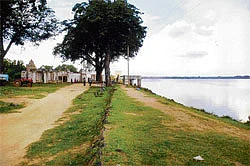
Kunigal tank, immortalised in a famous folk song, is among the bigger tanks in the State. Fifty years back, the tank was in all its glory, when water reached the brim and made for a refreshing sight. Around the time of Navarathri, water would touch the maximum level, and walking along the two-kilometre bund would make for a great experience. The sight of the frothy water coursing through various paths and eventually reaching the Mangala tank was indeed one for sore eyes. Water from this tank would feed thousands of acres of land in the taluk all through the year.
Farmers would grow paddy and sugarcane in the region, and Kunigal taluk came to be known as the paddy bowl. On the acres of land near the tank, mushroomed several jaggery-making units.
Those were golden years for farmers in the region. Today, though, things seem to have changed. Water sources that would lie somewhere in the foothills of the Shivaganga hill, which would feed the tank have now disappeared. All the tiny water bodies including pits and ditches in the catchment area of the tank have been encroached upon. Also, because a tank was built near Thippasandra in Magadi taluk, water depleted from Kunigal tank.
A chieftain’s vision
Like most tanks, there is an interesting story behind the construction of Kunigal tank. The tank area is said to have been covered with trees hundreds of years ago. It is believed that there were two small ponds called Gange and Gowri in the region. The Nagini and Nalini rivers that originate in the Shivaganga hill are said to have flowed through Kudur, Thippasandra, Kunigal, Kaggere and Mangala, eventually reaching Shivanasamudra. The Chola Kings are said to have thought up the idea of building a tank to check water from the rivers originating from the Shivaganga hill. The Kings were said to have entrusted the task of building the tank to a palegar, a local chieftain named Kotthappa.
Kotthappa decided to use the naturally occurring black stones spread across miles to line up as the tank’s bund. He started arranging the black stones in an order. A bund was built between Kotthagere and Kunigal. The chieftain is also said to have built the Someshwara temple, built in the Chola architectural style. The construction of the tank took several years to be completed. Yet, Kotthappa couldn’t rest. He decided to build another tank, 800 metres away from the Kunigal tank. He started laying out black stones too, as an embankment. At one point during the construction of this new tank, the chieftain looked at the two tanks from the peak of the Ranganathaswamu hill, about five kilometres away. The two tanks with the Shivaganga hill in the between made for a great sight. The chieftain had new thoughts now. Why not merge the two tanks, he asked himself.
That would then ensure that Kunigal tank became the biggest tank in the entire region. He dreamt of all the water that was till now flowing away, feeding thousands of acres of land.
Death of the visionary
But not many labourers, who were tired of the construction work, agreed to work on Kotthappa’s new vision. But, nothing, it seems dissuaded the chieftain. The labourers, in despair, decided to do away with the chieftain himself. They succeeded by plotting to bring the chieftain to the spot where they had dug a huge pit, into which he was pushed.
With his death died the plan to merge the two tanks. Kotthagere, the town, gets its name from this chieftain. Kotthappa’ s grave still lies here. A temple has also been built in the area. At one point, there was a mass-feeding programme in his memory, but that practice has stopped now.
The Kunigal tank is spread across a vast 1,030 acres of land. The embankment itself is 350-feet long. An overbridge was constructed in 1845. A bund was built to the Kottagere tank in 1886. The tank touched the brim in 1954, and later, owing to heavy rain, there were indications that the tank embankment might breach, at the spot where the Someshwara temple is situated. Alert authorities used explosives to blast the embankment towards the northern side of the tank. This is said to have saved Kunigal town. It is said that the Kaggere temple was flooded and there were heavy crop losses at that point in time.
The principal crop that was raised near the tank, sugarcane, has now disappeared. The paddy bowl tag has lost much of its sheen today. The coconut-arecanut plantations behind the tank that had once won praise from the Mysore kings, seem to have lost the glory of yore. The tank has seen some life though, over the past few years thanks to the struggle of the last 40 years to bring water from the Hemavathi river. The tank has even seen optimal water from the past few years.
This has come at a time when farmers in the region had lost all hope, and thought the tank was as good as dead. Because the twin tanks are now alive again, the water table in the region has shot up.
Water from the Kunigal tank is now being used to raise summer crops, thanks to the Hemavathi.
